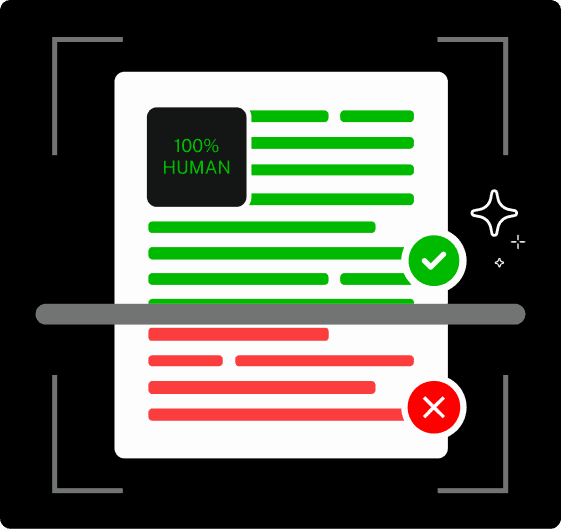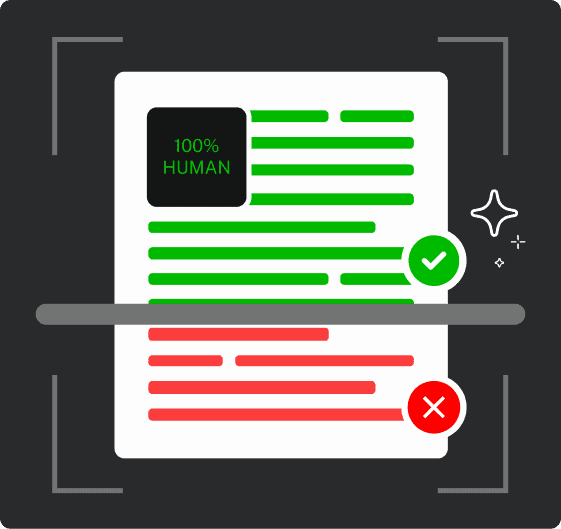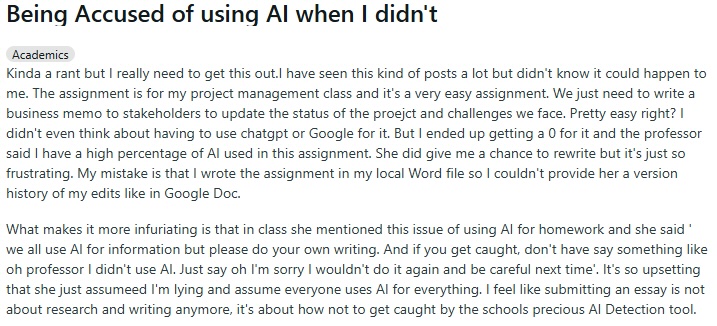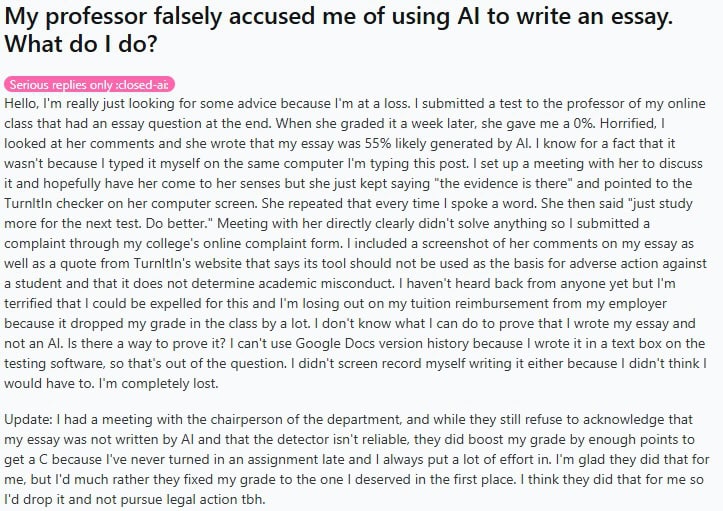One wrong flag. That’s all it takes to get an F, lose a writing job, or even get expelled.
Most AI detectors aren’t fair.
Think about it…
With just a 1% false positive rate, thousands of students could be wrongly accused every year. That’s thousands of students facing Fs or expulsion.
Their degree? At risk.
Their future? On pause.
False accusation → Academic misconduct hearing → Potential expulsion → Career derailment
So, what’s the fix?
Start by not blindly trusting AI detectors — especially when their own accuracy is questionable.
In this blog, we’ll walk you through real cases of false positives, break down how accurate these AI detectors, and show you how to protect yourself.
We’ll also cover what steps to take if you’ve been wrongly flagged — and how to handle it the smart way.
Let’s dive in.
Key Takeaways
- AI detectors have significant false positive rates (1-4%), potentially wrongly accusing thousands of students annually of academic dishonesty.
- Independent testing shows AI detectors are far less accurate than claimed, with some performing as low as 22-40% accuracy in real-world conditions.
- Non-native English speakers and neurodivergent students face higher risk of false accusations due to their naturally structured writing patterns.
- Students falsely accused should collect evidence (drafts, revision history, timestamps) and leverage institutional due process policies for appeals.
- Even prestigious documents like the U.S. Constitutions have been flagged as AI-generated, highlighting the unreliability of detection tools.
- The focus should shift from “Did you use AI?” to “How did you use AI responsibly?” with clear guidelines and proper citation practices.
Instances of False Accusations From AI Detectors
AI writing detectors are being used more widely, but are ai detectors accurate?
In fact, they’ve falsely accused students, teachers, and even content creators of using AI when they didn’t.
Here are five real examples that show how things can go wrong:
Never Worry About AI Detecting Your Texts Again. Undetectable AI Can Help You:
- Make your AI assisted writing appear human-like.
- Bypass all major AI detection tools with just one click.
- Use AI safely and confidently in school and work.
- Johns Hopkins Case
A professor at Johns Hopkins reviewed a student’s paper after Turnitin flagged over 90% of it as AI-written. After reading through her drafts and process, he confirmed it was entirely her own work. The tool simply got it wrong. - Standard Phrases Triggered a False Flag
A UK university student named Albert was accused of cheating after using common academic phrases like “In conclusion.” This pattern affects non-native English speakers who tend to write in simpler, more structured ways, similar to how AI often writes. - The Tools Miss More Than They Catch
In some studies, AI detectors were accurate less than 40% of the time. When students tried to hide AI use, that number dropped to just 22%. So even when AI was used, detectors often didn’t catch it—and when it wasn’t, they sometimes flagged it anyway.
4. A Reddit User Got a Zero
One student shared on Reddit how they received a zero on their assignment—despite writing it themselves—because an AI detector incorrectly flagged it.
5. Another Student Penalized for Typing Their Own Work
In another Reddit case, a student received a C on a paper they typed independently. The only evidence against them? The AI detector’s judgment.
How Accurate Are AI Detectors?
When asking how accurate are ai detectors, most AI detection tools claim to be over 95% accurate.
But even those same tools add a disclaimer: their results shouldn’t be treated as final.
We’ve already seen real-world cases where this disclaimer was the only thing standing between a student and a false academic penalty.
So yes—on paper, the tools look reliable. But independent testing tells a different story.
For example, ZDNet and other independent reviewers tested 10 detectors using real AI-generated and human-written text. The results were mixed:
- Copyleaks claimed high accuracy, but scored 80% in independent tests.
- GPTZero also reached 80% accuracy.
- Grammarly was only 40% accurate.
In those tests, Undetectable AI was one of the top few tools with GPTZero and Originality.ai which got the test accurate everytime. It showed consistency across different content types.
Many tools—Turnitin included—struggle with short, technical, or structured sentences.
In fact, Turnitin’s own staff admit their tool can show up to 4% false positives on sentence-level checks (Washington Post).
That happens when human-written content resembles the patterns AI tends to use—like common phrases or repetitive structure.
Undetectable AI avoids this issue by analyzing deeper patterns, reducing the chance of misclassification—even in tricky formats.
Most detectors sound good on paper. But when tested, only a few actually deliver.
What to Do If Falsely Accused of Using AI
False AI-generated content accusations are rising. When they happen, you have the choice to respond with evidence, strategy, and professionalism.
Here’s a step-by-step approach:
- Collect Your Writing Evidences
Look for the drafts and revisions, outlines and research notes, screenshots or timestamps (Google Docs history, browser activity).
If older assignments (pre-ChatGPT) also trigger the detector, use them to show pattern-based detection errors—not misconduct. This adds credibility.
Here’s how to present the evidences chronologically:
Draft 1 (Date/Time) → Notes → Outline → Final Version
But what if you don’t have the evidence?
That does make things more difficult, but you’re not out of options.
- Leverage your credibility. If you’ve consistently been a strong student or writer, showcase your previous work as a reference point. Use it to demonstrate your capability and writing style.
- You can also research the AI detector your instructor is using. Many tools include disclaimers in their user policies stating that results shouldn’t be treated as definitive proof.
- Highlight any grammar quirks, writing errors, or natural structure that AI typically doesn’t produce.
- Ask for the specific sentences that were flagged and review them together with your teacher.
- If nothing else works, offer to rewrite the assignment in person under supervision to prove your ability.
- Use Evidence Against Detector Reliability
Support your case with facts. For example,
- The U.S. Constitution was once flagged as AI-generated (source: Washington Post)
- OpenAI shut down its own detector due to poor performance
- Turnitin admits a 4% false positive rate at the sentence level
- Independent benchmarks show varying accuracy across tools—from 50% to 100%
- Invoke Institutional Policy & Due Process
Ask politely for a copy of your school’s academic honesty rules. Most schools (and even Turnitin) don’t allow punishment based only on AI scores. You have the right to:
- Appeal processes
- Hearing representation
- A review by neutral parties
Use formal language and stay composed. Position yourself as cooperative, not defensive.
What AI Detectors Are Teachers Using?
How can professors detect Chatgpt?
Here’s a simple breakdown of the most common AI detectors being used in schools and colleges today:
- Turnitin is the default for most institutions. This AI detector is used by over 16,000 schools and integrated into nearly every major LMS.
- GPTZero is free and popular but flawed. Multiple tests show a high false-positive rate, especially with non-native English speakers. Not ideal for serious decisions.
- Copyleaks claims 99.1% accuracy. But independent reviews found it misflags human writing. Good branding—questionable real-world performance.
- Winston AI is common in K–12 settings. Built for teachers and school admins. But it’s not transparent. No public benchmark data, no error rates shared. Hard to trust in high-stakes situations.
- Originality.ai is gaining traction in colleges and content teams. Strong in blind testing. Fewer false flags than others.
- Undetectable AI stood out with 100% accuracy in independent testing. It performs well on short and technical writing.
Turnitin’s AI Detector: Helpful or Problematic?
Let’s analyze turnitin AI detection false positive rate, Turnitin is used in schools and universities all over the world. Most teachers rely on it to check if a student used AI.
But how accurate are AI detectors like Turnitin?
Turnitin says its AI detector is 98–99% accurate. They also admit there’s a false positive rate of up to 4%. That means it can wrongly flag work done by a real human.
Even a 1% error rate would flag 22,000 innocent students out of 2.2 million each year in the U.S. At 4%, that’s 88,000 students wrongly accused of cheating. That’s not a small problem.
In May 2025, a student at the University at Buffalo found out her final papers were flagged by Turnitin. She wrote them herself. But the system said they were likely written by AI.
About 20% of her classmates were flagged too. The university later said they don’t rely only on AI tools to make decisions, but the stress was already there. Her graduation was at risk.
Turnitin’s AI tool became available in 2023. By late 2023, over 70 million assignments had been scanned by it. Most students don’t even know it’s being used.
So what’s the truth about the Turnitin AI detection false positive rate?
Turnitin’s AI detector can be helpful. It can point out writing that feels off.
But it can also make big mistakes. It’s a tool—not a judge.
Used carefully, it can support teachers. Used blindly, it can harm students.
Can You Avoid Being Falsely Flagged by AI Detectors?
Yes. You have to be very mindful.
AI content detectors flag writing based on certain patterns.
If your writing looks too polished, too neutral, or too generic, it might get flagged, even if you wrote it yourself.
The key is breaking those patterns before you submit.
Option # 1: Use humanizing tools. AI Humanizer, for instance, can help you rewrite AI-generated text in a way that mimics human style.
It targets deeper patterns—the structure, rhythm, and phrasing that detectors look for.
As a result, your text becomes much harder to flag, even if it started as AI-generated.
Option # 2: Use rephrasing tools. This paraphrasing tool can paraphrase AI content and reduce detection risk.
Option # 3: The safest route is to add your voice. Use personal examples. Mention class materials. Include thoughts you’ve discussed in your course.
Even if you use AI to start, don’t submit it word for word. Mix it with your own input.
Detectors aren’t good at spotting hybrid writing that includes personal style.
Why Honest Students Are Turning to Undetectable AI
False flags are real. Even original work can get flagged as “AI-written.”
One mistake from the detector and your grade, or reputation, takes a hit.
That’s why, students use Undetectable AI because of three solid reasons:
- Over 15 million people started using it in just 18 months (Reuters). It is because this tool is largely trusted by third-parties.
- It protects your effort by helping you detect the AI content correctly. You spend hours writing. You shouldn’t lose credit because a detector misreads your tone or phrasing.
- It changes how the writing “sounds” to AI. The AI Humanizer tweaks structure, sentence flow, and rhythm. Same meaning, just different style. More human, and less robotic.
Impact on Non-Native English Speakers and Neurodivergent Students
Many studies show that non-native English speakers and neurodivergent students are more likely to be wrongly flagged by AI detection tools.
It is because they often use simple sentences and common words — the same patterns AI tools are trained to see as “AI-written.”
- A study from Stanford found that 20% of essays written by non-native speakers were wrongly flagged as AI. That means international and ESL students can get in trouble just because of how they naturally write.
- The same problem happens with neurodivergent students. Turnitin’s AI tool flagged more essays from students with ADHD, autism, or dyslexia — likely because of how they write or the tools they use to help them.
The Real Conversation Teachers Should Be Having
AI is here, and it’s not going away. It’s only getting more advanced by the hour.
When calculators came, they didn’t make students lazy — they helped save time and do more.
We should look at AI the same way.
The question shouldn’t be, “Why did you use AI?” The real question should be, “How did you use it?”
Here are some ways teachers can introduce AI to students:
- Teach AI the right way.
Teachers should learn how tools like ChatGPT work and where they can go wrong.
- Set clear rules.
Teachers should clearly say if AI is allowed or not. If it is, students should be told how to cite it properly (APA/MLA now include AI citation rules).
- Design smarter assignments.
To prevent misuse or false flags, teachers can assign in-class essays, oral presentations, or tasks based on recent events that AI tools don’t know much about.
- Use human judgment.
Instead of relying only on detection tools, teachers should pay attention to how each student normally writes. If something feels off, have a conversation. “Know your students, know their writing style.”
Experience the power of our AI Detector and Humanizer in the widget below!
FAQs
Are AI detectors used as final judgment in universities?
No. AI tools are not final proof. Teachers are supposed to use their own judgment. Most schools and even AI detectors say that a detector flag should not be used as a punishment.
How do I prove I didn’t use ChatGPT?
Share your drafts, notes, or older essays. Offer to do a live writing test. Show issues in the AI report. You can also mention research showing these tools make mistakes.
Can I still use writing tools without being flagged?
Yes. Tools like Undetectable AI are safe. The AI Humanizer & Paraphraser often don’t get flagged. Just make sure the ideas are yours and follow any class rules.
Conclusion
Are AI detectors accurate?
Not all of them.
AI detectors aren’t going anywhere, but neither are their flaws.
The technology that’s supposed to protect academic integrity is creating new problems—false accusations, biased results, and damaged futures.
The solution isn’t to ignore AI or pretend these tools work perfectly. It’s to be smarter.
But how?
Document your work. Know your rights. Understand the limitations of detection technology. And when necessary, protect your legitimate efforts from algorithmic errors.
The future of education depends on finding the right balance between preventing misuse and protecting honest students.
Until that balance is found, the responsibility falls on you to safeguard your academic reputation.
Don’t let a flawed algorithm decide your future.
Try Undetectable AI today and safeguard your hard work from false accusations.






